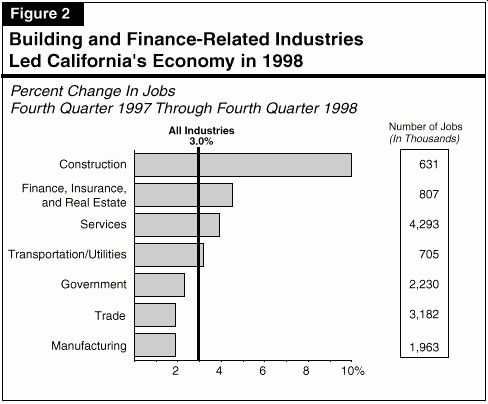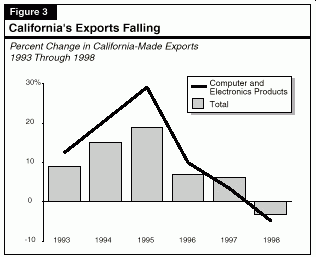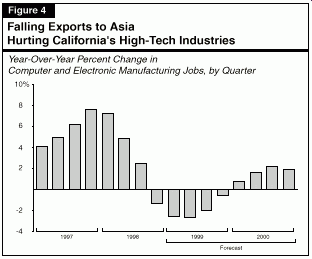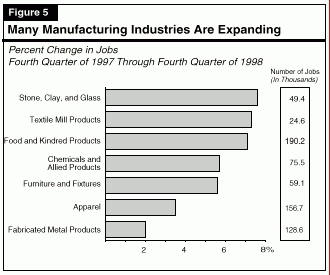![]()
California's severe recession contributed to the major budgetary shortfalls confronting policy makers in the early 1990s. More recently, healthy economic expansion provided funds for both increased spending and tax relief in each of the past two budgets. The Governor's proposed budget for 1999-00 assumes that economic growth will continue in 1999 and 2000, but at a more subdued pace than in the past two years.
In this part, we review recent economic and demographic developments, discuss the forecasts contained in the 1999-00 Governor's Budget, and provide our own perspective on California's economic and demographic outlook.
Despite concerns about the adverse impacts of Asia's economic and financial problems, both the U.S. and California economies experienced a year of healthy economic growth and low inflation in 1998. The positive trends continued through year-end, and 1999 is beginning with both the national and state economies in good shape.
The U.S. economic expansion entered its eighth year in 1998, and is showing no signs of faltering. As shown in Figure�1, real gross domestic product (GDP) increased by 3.8�percent in 1998, the fourth year in the past five that growth in U.S. economic output has exceeded 3�percent. Growth in 1998 significantly exceeded the consensus of forecasts made at the beginning of the year (which called for a 2.5�percent increase).

Asia's economic problems resulted in a deterioration in the U.S. trade balance during the year. However, weakness in this sector was offset by surprisingly strong growth in other sectors--particularly consumer spending on durable goods, home construction, and business investment--which benefitted from low inflation and interest rates. Specifically:
The international trade sector weakened in 1998, as expected, due primarily to Asia's economic problems. During the year, exports were flat, while imports jumped by over 10�percent. This caused the trade deficit to increase from $93�billion in 1997 to $162�billion in 1998, subtracting nearly 1�percentage point from overall 1998 GDP growth.
Inflation and Interest Rates Declined. Two of the more positive developments in 1998 were the unexpected declines in both inflation and interest rates--very unusual occurrences for the eighth year of an economic expansion. The increase in the Consumer Price Index (CPI) fell from 2.3�percent in 1997 to 1.6�percent last year, while the growth rate in the U.S. GDP implicit price deflator fell from 1.9�percent to 1�percent. These declines were brought about by lower international prices of oil, agricultural products, raw materials, and other commodities, caused in part by weak demand in Asia. These declines offset the effects of higher labor-related wage and benefit costs on U.S. product prices.
The combination of low inflation, monetary easing by the Federal Reserve Bank, and a federal budget surplus, contributed to a decline in interest rates in 1998. For example, the interest yield on 30-year Treasury bonds fell from slightly over 6�percent in the fourth quarter of 1997 to slightly over 5�percent by the fourth quarter of 1998.
Low inflation contributed to gains in the purchasing power of U.S. households, which in turn helped boost consumer spending during the year. Similarly, the drop in interest rates contributed to increases in home sales and construction spending in 1998.
Like the nation, California's economy experienced healthy economic growth in 1998--despite the adverse impacts of Asia's economic and financial problems on key industries and geographic regions within the state:
Job Performance By Industry. Figure�2 shows that all major employment categories increased between the fourth quarter of 1997 and the fourth quarter of 1998. The fastest growing sectors were construction, finance, and services, reflecting increases in consumer spending and real estate activity. More modest gains were posted by the transportation/utilities, trade, government, and manufacturing sectors.

Over the past 12 months, the major risk facing the U.S. and California economic expansions has been the potential adverse impacts of the financial and economic problems in Asia. A key concern was that the crisis would lead to a substantial slowdown in the U.S. economy, caused by major U.S. oversees investment losses, slowing exports, and rising imports from abroad. California was thought to be particularly vulnerable to Asia's problems, given that nearly one-half of the state's exports are to that region. An additional concern was that Asia's problems would spread to other global regions, including such emerging economies as Russia and those in Latin America.
Developments over the past year indicate that the worst fears regarding Asia's problems have not materialized. While Asia's problems have hurt high technology industries, the damage has thus far been largely offset by the positive effects on other sectors of lower interest rates and inflation.
Growth in California exports was a key factor behind the early stages of California's current economic expansion. As shown in Figure�3 (see next page),
total exports of California-produced goods increased by as much as 19�percent in 1995, led by major increases in computer and electronics shipments
abroad. More recently, however, computer and electronics exports have slowed sharply, reflecting significant declines in sales to Asian countries. This led
to a 3�percent decline in total California exports during the first three quarters of 1998 compared to the same period of the prior year.

The slowdown in computer and electronic exports has clearly had a negative effect on the state's high-tech industries. As shown in Figure�4 (see next
page), employment growth in California's computer and electronics industries, which had been strong between 1995 and 1997, subsided beginning in early
1998, and turned negative during the fourth quarter of the year.

Outside of high-tech and a few other industries directly affected by falling exports to Asia, the picture has been much brighter. As indicated above, both falling interest rates and low inflation have boosted consumption and real estate activity nationally and in California. Industries benefitting from these developments are experiencing healthy employment gains.
Even within the manufacturing sector there was a notable split between the performance of the high-tech category and other industry categories during the year. In terms of jobs, the declines in high-tech manufacturing were offset by increases in a number of other sectors. Such building-related sectors as stone-clay-glass and furniture-fixtures posted healthy gains during 1998 (see Figure�5).

Taking into account these positive and negative factors, Asia's impact on overall economic growth thus far has been a "mixed bag," with some industries suffering, and others actually benefitting from lower interest rates and inflation.
While the effects of Asia's crisis have so far been muted by other factors, the state and the nation remain vulnerable to potential further negative developments abroad. For example, further steep declines in exports to Asia could deepen and thus exacerbate the current downturn in California's high-tech industries, thereby undercutting consumer and business confidence in the state's economy. Thus, the outlook for Asia is very important. The key issue is the extent to which Asia's problems will continue to pull down U.S. and California economic growth in the future.
At this point, there are encouraging signs that the Asian economic region as a whole is nearing the bottom of its "down" cycle, and that a recovery could begin late this year. However, the outlook remains fraught with risk, and serious problems could remain well into next year.
With regard to Japan (which is California's largest trading partner), analysts generally expect that the major fiscal stimulus package adopted by the Japanese government last year will help ease that country's recession, and eventually lead to a rebound. According to the "consensus" estimate of international forecasts, real GDP in that country is projected to decline by less than 1�percent in 1999 (compared to a 2.7�percent decline in 1998), before growing by 1�percent in 2000.
Other Asian countries are also showing signs that their economies are approaching the bottom of their economic cycles. The rates of decline in economic activity have been diminishing in many countries. In addition, inflation is stabilizing, and reforms adopted over the past year are beginning to take effect. Finally, stock markets in the region have stabilized and there are signs that foreign investment is slowly returning to the region.
While the region continues to face challenges associated with large loan losses and other factors, even a mild improvement will help stabilize the recent decline in California exports. This should, in turn, permit some recovery in the state's high-tech industries by late this year (see Figure�4 earlier).